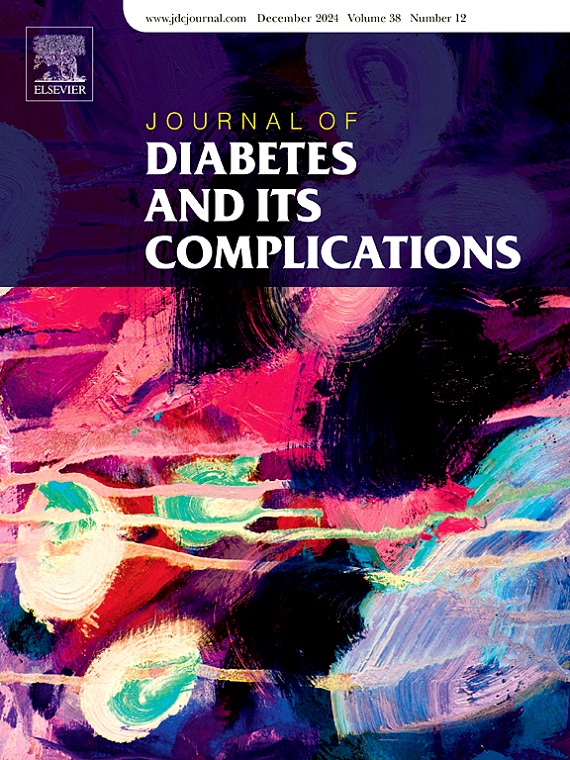替西肽与2型糖尿病患者勃起功能障碍的关系
IF 3.1
3区 医学
Q3 ENDOCRINOLOGY & METABOLISM
引用次数: 0
摘要
目的:与西格列汀、注射用西马鲁肽和杜拉鲁肽比较,评价替西帕肽与男性2型糖尿病(T2D)患者发生勃起功能障碍(ED)风险之间的关系。方法采用TriNetX全球健康研究网络,于2022年5月13日至2025年5月17日进行回顾性队列研究。纳入年龄在18-70岁的男性T2D患者,既往无ED。进行了三个1:1倾向评分匹配的比较:替西帕肽与西格列汀、可注射的西马鲁肽或杜拉鲁肽。结果是诊断为ED或处方PDE-5抑制剂。结果在所有的比较中,舒帕肽与ED风险的显著降低相关。ED诊断或使用PDE-5抑制剂的复合结局的风险比(RR)为:替西帕肽vs西格列汀:RR, 0.70 (95% CI: 0.64,0.76);替西帕肽vs.注射用西马鲁肽:RR, 0.67 (95% CI: 0.62,0.72);替西帕肽vs杜拉鲁肽:RR, 0.55 (95% CI: 0.51,0.59)。所有比较均有统计学意义(p <;0.001)。结论与西格列汀、可注射的西马鲁肽和杜拉鲁肽相比,斯特西帕肽与T2D男性ED的风险较低相关。需要随机试验来证实这些发现并探索潜在的机制。本文章由计算机程序翻译,如有差异,请以英文原文为准。
Association of tirzepatide with erectile dysfunction in people with type 2 diabetes
Aims
To evaluate the association between tirzepatide and the risk of developing erectile dysfunction (ED) in men with type 2 diabetes (T2D), compared with sitagliptin, injectable semaglutide, and dulaglutide.
Methods
This retrospective cohort study used the TriNetX global health research network from May 13, 2022 to May 17, 2025. Male patients aged 18–70 with T2D and no prior ED were included. Three 1:1 propensity score-matched comparisons were conducted: tirzepatide vs. sitagliptin, injectable semaglutide, or dulaglutide. The outcome was a diagnosis of ED or prescription of a PDE-5 inhibitor.
Results
Tirzepatide was associated with a significantly reduced risk of ED across all comparisons. Risk ratios (RR) for the composite outcome of ED diagnosis or PDE-5 inhibitor use were: tirzepatide vs. sitagliptin: RR, 0.70 (95 % CI: 0.64,0.76); tirzepatide vs. injectable semaglutide: RR, 0.67 (95 % CI: 0.62,0.72); tirzepatide vs. dulaglutide: RR, 0.55 (95 % CI: 0.51,0.59). All comparisons were statistically significant (p < 0.001).
Conclusions
Tirzepatide was associated with a lower risk of ED in men with T2D compared to sitagliptin, injectable semaglutide, and dulaglutide. Randomized trials are needed to confirm these findings and explore potential mechanisms.
求助全文
通过发布文献求助,成功后即可免费获取论文全文。
去求助
来源期刊

Journal of diabetes and its complications
医学-内分泌学与代谢
CiteScore
5.90
自引率
3.30%
发文量
153
审稿时长
16 days
期刊介绍:
Journal of Diabetes and Its Complications (JDC) is a journal for health care practitioners and researchers, that publishes original research about the pathogenesis, diagnosis and management of diabetes mellitus and its complications. JDC also publishes articles on physiological and molecular aspects of glucose homeostasis.
The primary purpose of JDC is to act as a source of information usable by diabetes practitioners and researchers to increase their knowledge about mechanisms of diabetes and complications development, and promote better management of people with diabetes who are at risk for those complications.
Manuscripts submitted to JDC can report any aspect of basic, translational or clinical research as well as epidemiology. Topics can range broadly from early prediabetes to late-stage complicated diabetes. Topics relevant to basic/translational reports include pancreatic islet dysfunction and insulin resistance, altered adipose tissue function in diabetes, altered neuronal control of glucose homeostasis and mechanisms of drug action. Topics relevant to diabetic complications include diabetic retinopathy, neuropathy and nephropathy; peripheral vascular disease and coronary heart disease; gastrointestinal disorders, renal failure and impotence; and hypertension and hyperlipidemia.
 求助内容:
求助内容: 应助结果提醒方式:
应助结果提醒方式:


